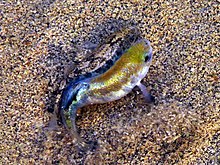The Death Valley pupfish (Cyprinodon salinus), also known as Salt Creek pupfish, is a small species of fish in the family Cyprinodontidae found only in Death Valley National Park, California, United States. There are two recognized subspecies: C. s. salinus and C. s. milleri. The Death Valley pupfish is endemic to two small, isolated locations and currently classified as endangered.
| Death Valley pupfish | |
|---|---|

| |
| Male (right) and female (left) | |
| Scientific classification | |
| Domain: | Eukaryota |
| Kingdom: | Animalia |
| Phylum: | Chordata |
| Class: | Actinopterygii |
| Order: | Cyprinodontiformes |
| Family: | Cyprinodontidae |
| Genus: | Cyprinodon |
| Species: | C. salinus
|
| Binomial name | |
| Cyprinodon salinus R. R. Miller, 1943
| |
| Subspecies | |
| |
Description
editThe Death Valley Pupfish is a small, silvery colored fish with 6–9 vertical dark bands on its sides. It has an average length of 3.7 cm (1.5 in), with a recorded maximum of 7.8 cm (3.1 in).[3]
The males, often appearing in larger sizes compared to females, turn bright blue during mating season, April through October. The females, along with premature pupfish, tend to have tanned backs with iridescent, silvery sides. Both males and females have plump bodies with rounded fins, a squashed head and an upturned mouth.[4] The pupfish can withstand harsh conditions that would kill other fish: water that is 4 times more saline than the ocean, hot water up to 116 °F (47 °C), and cold water down to 32 °F (0 °C).[5]
Distribution and habitat
editThis species is known from only two locations in Death Valley: Salt Creek (subspecies salinus) at about 49 m (161 ft) below sea level, and Cottonball Marsh (subspecies milleri), at about 80 m (260 ft) below sea level.[1] They are thought to be the remainders of a large ecosystem of fish species that lived in Lake Manly, which dried up at the end of the last ice age leaving the present-day Death Valley.[6]
The Salt Creek subspecies is also found at River Springs and Soda Lake, in Death Valley National Park.[5]
Conservation
editThe Death Valley pupfish has been classified as endangered by the IUCN because of its extremely restricted distribution (if the two extant locations were treated as a single unit, it would be considered critically endangered). Numbers of individuals at the locations are highly seasonally variable, and fluctuate with water level and flow volume. While the entire range of the species is located in a protected area, it may be under threat from accidental introduction of non-native species, local catastrophic events, and excessive pumping of the aquifer that feeds the habitat.[1]
See also
edit- Tecopa pupfish, Cyprinodon nevadensis calidae (extinct)
- Saratoga Springs pupfish, Cyprinodon nevadensis nevadensis, from Saratoga Springs at the south end of Death Valley
- Amargosa pupfish, Cyprinodon nevadensis amargosa, from the Amargosa River northwest of Saratoga Springs
- Devils Hole pupfish, Cyprinodon diabolis, critically endangered and found in Devils Hole in western Nevada
- Shoshone pupfish, Cyprinodon nevadensis shoshone
- Desert pupfish, Cyprinodon macularius
- Owens pupfish, Cyprinodon radiosus
References
edit- ^ a b c NatureServe (2013). "Cyprinodon salinus". IUCN Red List of Threatened Species. 2013: e.T62211A15362833. doi:10.2305/IUCN.UK.2013-1.RLTS.T62211A15362833.en. Retrieved 20 November 2021.
- ^ NatureServe (7 April 2023). "Cyprinodon salinus". NatureServe Network Biodiversity Location Data accessed through NatureServe Explorer. NatureServe. Retrieved 17 April 2023.
- ^ Froese, Rainer; Pauly, Daniel (eds.). "Cyprinodon salinus". FishBase. December 2015 version.
- ^ "Natural History". Center for Biological Diversity.
- ^ a b "Salt Creek pupfish". U.S. Bureau of Land Management. Archived from the original on 2016-06-11. Retrieved 2016-05-15.
- ^ US Geological Survey (30 June 2000). "Shoreline Butte: Ice age Death Valley". Death Valley Geology Field Trip Shoreline Butte. Department of the Interior. Archived from the original on 2015-04-30. Retrieved 2009-09-10.
Further reading
edit- Duvernell, D. D.; Turner, B. J. (1999). "Variation and divergence of Death Valley pupfish populations at retrotransposon-defined loci" (PDF). Molecular Biology and Evolution. 16 (3): 363–371. doi:10.1093/oxfordjournals.molbev.a026117.
- Lema, S. C. (2008). "The phenotypic plasticity of Death Valley's pupfish: desert fish are revealing how the environment alters development to modify body shape and behavior". American Scientist. 96 (1): 28. doi:10.1511/2008.69.3668.
- Jahren, A. H.; Sanford, K. L. (2002). "Ground-water is the ultimate source of the Salt Creek pupfish habitat, Death Valley, U.S.A" (PDF). Journal of Arid Environments. 51 (3): 401–411. Bibcode:2002JArEn..51..401J. doi:10.1006/jare.2001.0950.
External links
edit- Media related to Cyprinodon salinus at Wikimedia Commons
- "Cyprinodon salinus". Integrated Taxonomic Information System. Retrieved 18 January 2014.

